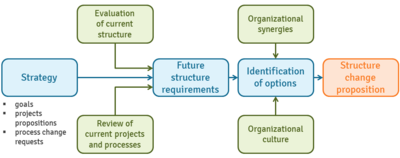Structure follows strategy
| Structure follows strategy |
|---|
| See also |
Structure follows strategy is a business principle coined by A.D. Chandler in 1962 that states that organizational structure of corporation (the divisions, departments, teams, processes and technology) are designed to achieve a firm's strategy. Chandler covered the crucial role of the company's strategy and pointed to the close relationship between the company's strategy and structure thanks to the research conducted on US corporations operating in the years 1850-1920. Chandler is the author of the quote: If the structure does not support the strategy, the result is inefficiency. He described the strategy as a way to set long-term goals and understood the structure as a way of operating the organization through which the strategy should be implemented. His observations were accurate, as they described the problems of modern American business. American business at the time created many monopolists, who began to lose their dynamism and competitiveness due to the excessive bureaucracy and internal activities that acted to the detriment of customers.
Reasons of existence of this relationship was that:
- employees and resources is key factor of every strategy, and need to be acquired in order to achieve its goals
- proper division of work in form of functional structure and departmental structure increase efficiency of strategic actions
- growth of the firm and acquisition of new markets require strong organizational basis
The 7-S framework
In the current world of fast-growing development, an organization must be flexible to be able to adapt to changing requirements, environments and technologies. The most important challenge of modern times is to create such a structure of the organization so that it is not necessary to redesign it all the time when the parameters like product or customer type changes. Activities are based on solutions that enable reorientation of new challenges and opportunities without the need to introduce drastic changes in the existing structure and functions. Effective organizational change results not only from the relationship with structure and strategy, but also from the interaction between another factors like systems, style, skills, staff and superordinate goals and its called the S-7 framework (R. H. Waterman, Jr., T. J. Peters, J. R. Philips, s. 17-18).
The seven factors for effective strategy execution (R. S. Kaplan 2005, s. 1):
- Structure - the way of formal organization of the company according to the division into positions, departments and other organizational units and delegating duties and information flow between them,
- Strategy - is a program of the company's activity that uses production potential and resources to achieve the intended goals and strengthens its position in relation to the competition,
- Systems - formal and informal procedures for managing the organization, e.g. management control systems, planning systems, information systems, budgeting systems, social systems,
- Staff - people who create the organization and their competences,
- Skills - a company's crucial attributes, areas that distinguish its from others,
- Style - the organizational culture (the values, the norms),
- Superordinate goals - a set of values and aspirations, fundamental ideas around which a business is built.
References
- Chandler, A. D. Jr. (1962). Strategy and Structure: Chapters in the History of the American Industrial Enterprise. Cambridge, MA: MIT Press
- Hall, D. J., & Saias, M. A. (1980). Strategy follows structure!. Strategic management journal, 1(2), 149-163.
- Waterman R. H. Jr., Peters T. J., Philips J. R. (1980). Structure Is Not Organisation. Business Horizons.
Author: Anna Gołdyn
.
